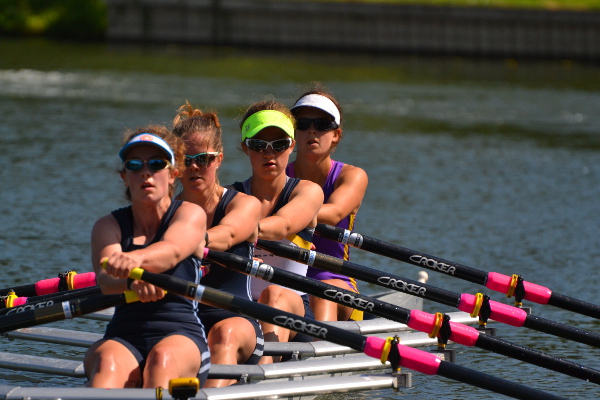Chris O’Hara is a full-time rowing coach working with Oxford University. The ladies 4 x lightweight scullers (four people, two oars each) are heading to the European Universities Games 2014 in Rotterdam at the end of July, and he is determined they will be at their best.
But how does a sports coach differ from a business coach? What are the similarities? Are there transferrable skills? I decided it was worth spending a sunny morning on the Thames to find out.
Chris does not spend his life riding a bicycle down a towpath shouting through a megaphone at people in boats; he has to maintain equipment, design training schedules, consult with nutritionists, sort out logistics to get the team to various events and competitions, paperwork, etc., but there is a megaphone to go with the gruelling training regime: we went out for two hours at 9.30am, and the team had already been out for a two-hour session earlier!
Here are a few observations from my morning with Chris and the team:
Incremental change
Like many teams I work with, Chris looks for small, incremental changes. If the team can save a fraction of an inch per stroke, it can add up to half a boat length by the end of the race. “Races have been won by a lot less”, he stressed when explaining why they were spending so much time looking at how the oars were coming out of the water. We too should always look for small incremental improvements to steadily improve: keeping what benefits us, losing what doesn’t.
Advice from others
Nobody expects Chris to coach the team in isolation. Although he is focused on their success, he needs the help of other specialists, such as nutritionists. I often come across Scrum Masters, and even coaches, who think that they can’t ask for help from others outside the team. You can. You should.
Drive
The four rowers choose to get up at 5am most days for hours of gruelling training because they are spurred on by a drive to win; they are not paid. In fact, they often hide their involvement from their tutors because it is frowned upon by many academics who feel that the hours spent rowing should be used for studying. They want Chris to help them. I imagine that they don’t love his suggestions after two hours of hard rowing, but they appreciate that he is helping them achieve their goal and will listen to his suggestions.
Your team is paid. The coach has often been brought in by management, not at the bequest of the team. Not everyone wants you there. Many people just want to go to work, do their stuff, go home. Improvement is not everyone’s goal.
However, we are both judged by our teams success.
Subject Expert
Chris was a rower at Sydney University. But he says that many professional rowing coaches are not ex-rowers. Seeing opportunities for improvement and coaching a team is a skill that is separate from the ability to row. After uni, he worked in the rat race until he got to the position where he could do what he loved: being on water. You don’t need to have been a dev and tester to coach a team. There will be times when it will help, but there are also going to be times when you miss something because you don’t have a fresh perspective.
Motivation
After hours of rowing, I imagine that moods falter. From the outset, Chris talked in a calm and mellow tone. He rarely raised his voice (with one exception towards the end where he urged them to dig deep). His vocabulary was careful and considered.
- Recommendations were soft, using words and phrases like “slightly”, “a little earlier”, “a bit of water flicked up”, “it’s not quite where we want to be”, “squeeze a bit more off the finishes”. He was not alarmist nor too hard. Again, we come back to small, incremental changes.
- There were often positive words along with the recommendations: “It’s good here, here and here … but we could flatten this out” and “You’re a bit behind, but it’s fine”.
- Whilst we often shy away from directing our attentions at individuals, Chris would target his suggestions and credit individuals on their strengths.
- He let the team self-organise within certain boundaries. The rower at the front of the boat will navigate the river by steering with her feet, but Chris highlighted when he saw them getting too close to the bank; he warned when he saw a big boat coming around a bend; he let them choose the number of reps (for example, 24 or 26).
- He valued their input and got them involved in their own coaching: “What could be better, Ellie?”, Chris asked during one rest period, looking for suggestions for the crew as a whole. “Sarah, what’s feeling better than the other day?”.
- He offered encouragement when they did well, but pushed them when he thought it would help. He tells them to rest when he sees they need it.
If you’re a coach, much of the above will have resonance, but some will seem alien. Hopefully, you are already looking for small, evolutionary changes. You should be asking other experts to help the team. No doubt there is self-organisation going on. But do you offer enough encouragement when the team does well, push them when you think it is good for them, and tell them to rest when appropriate? Do you consider the words you use enough? If you have the opportunity to watch a coach at work, take it. You’ll find a sense of kinship, but you’ll also learn a lot about yourself.




Pingback: Scrum & Kanban – Coaching v Mentoring
I’m happy to report that the crew won gold in Rotterdam by a margin of over 13 seconds! http://eugames2014.eu/sports/rowing/match-schedule-and-results/
Well done ladies.
Pingback: Coaching v Mentoring – Scrum & Kanban